Hazelnut Sage Pesto Recipe

This hazelnut sage pesto recipe is quick and easy to make, a simple way to add a beautiful depth of flavor whether you have it with pasta, pizza or veggies. It’s also completely vegetarian, gluten-free, and easily made vegan, so it’s a perfect crowd pleaser!
About Sage
Sage is an aromatic herb and member of the mint family, like oregano, basil, rosemary and thyme. Sage leaves have a strong, earthy taste which is beautiful in a variety of dishes.
Buy our Weekly Meal Planning Printable for $3.33. 💜
Fresh sage leaves have an even fuller flavor than dried leaves, and they’re easy to grow in your backyard. I love growing sage because it means I always have a supply of fresh leaves. Plus, they make a great addition to the garden, as they give off a wonderful fragrance when you walk past them.
As well as being used for cooking, sage features heavily in folklore! For example, Sage is used in many cleansing rituals and is reputed to strengthen the senses and memory. It’s also believed that sage growing in your garden signifies prosperity.
It’s not just folk tales that speak of the benefits of sage. It also offers several health benefits:
- Sage is high in Vitamin K and contains magnesium, zinc, copper and Vitamins A, C and E.
- It’s high in antioxidants which help to prevent chronic illness.
- It’s thought to have antimicrobial effects, which are beneficial in fighting germs in the mouth. An old remedy for toothache is chewing on a sage leaf.
- Sage is also thought to lower LDL (bad) cholesterol and lower blood sugar levels.
Recipe Ingredients
To make, you will need:
- Fresh sage leaves: you will want to use fresh over dried.
- Extra virgin olive oil: this is a good recipe to use your best olive oil in.
- Fresh basil leaves: fresh is best.
- Blanched and roasted hazelnuts: you can purchase hazelnuts that are already blanched and roasted, which adds an extra dimension of flavor, but if you prefer raw hazelnuts, you can use that, too.
- Shredded parmesan cheese (or nutritional yeast if you are making vegan pesto): a cheesy umami flavor is essential in any good pesto!
- Garlic cloves (peeled): no good pesto is without the sharpness of raw garlic.
- Lemon juice or apple cider vinegar: either of these acids work well for flavor balance.
- Sea salt.
- Freshly ground black pepper.
How to Make Sage Pesto - Step-by-Step Instructions
To make Hazelnut Sage Pesto, simply combine all of your ingredients in a food processor or blender, and blend until smooth. Told you it was quick and easy!
You can either enjoy your pesto right away or store it in the fridge or freezer. It will keep in the refrigerator for up to a week and three months in the freezer.
How to Use Sage Pesto
There are so many ways to use sage pesto! It’s easy to stir through almost anything, and it makes a great condiment, too.
Some of my favorite ways to use sage pesto are:
- Use it to coat pasta and veggies for a quick weeknight meal.
- Mix through creamy arborio rice to create an aromatic pesto risotto.
- Make a satisfying pesto swirl cornbread.
- Treat yourself with these tasty (and vegan!) pesto pizza rolls.
How to Freeze Sage Pesto
Sage pesto freezes well, and it’s great to have on hand for those nights when you just aren’t sure what to make for dinner.
If you want to freeze sage pesto, I would recommend pouring it into ice cube trays first. Each pesto cube is about right for a serving, and it’s much easier than trying to separate a whole block!
Once you’ve frozen your pesto, it should last in the freezer for about three months.
FAQ
Is pesto healthy?Pesto contains olive oil, nuts and cheese, so it is high in calories. However, you won’t need to use much pesto in most recipes, so you don’t need to consume too many.
What is nutritional yeast?Nutritional yeast comes from a species of yeast called saccharomyces cerevisiae, the same yeast used for brewing and baking.
Although it comes from the same species, the nutritional yeast you can buy is quite different from baking and brewing yeast because it’s gone through a different process.
The saccharomyces cerevisiae yeast is fed a sugar-rich diet to enable it to multiply. Heat is then applied to deactivate it, and it’s dried and crumbled to create the yellow nutritional yeast flakes you buy.
Often, B-Vitamins and other nutrients are added to nutritional yeast to fortify it.
It’s naturally gluten-free, fat-free and low in calories and sodium.
Other Pesto Recipes
If you like this recipe, you’ll love these pesto recipes:
- Easy Vegan Cashew Pesto
- Cheesy Vegan Walnut Pesto (Gluten-Free)
- Beet and Pumpkin Seed Pesto (Gluten-Free)
📖 Recipe
Hazelnut Sage Pesto Recipe
Recipe details
Ingredients
- 1 cup fresh sage leaves
- 3/4 cup extra virgin olive oil
- 1/2 cup fresh basil leaves
- 1/2 cup blanched and roasted hazelnuts or any kind you prefer
- 1/4 cup shredded parmesan cheese or nutritional yeast for a vegan option
- 3 garlic cloves
- 2 tablespoons lemon juice or apple cider vinegar
- 3/4 teaspoon sea salt
- 1/4 teaspoon freshly ground black pepper
Instructions
- In a blender or food processor combine the sage, olive oil, basil, hazelnuts, parmesan (or nutritional yeast), garlic, lemon juice or vinegar, salt and black pepper.
- Blend until smooth.
- Use right away or keep it stored in the refrigerator for up to one week.
- Enjoy!








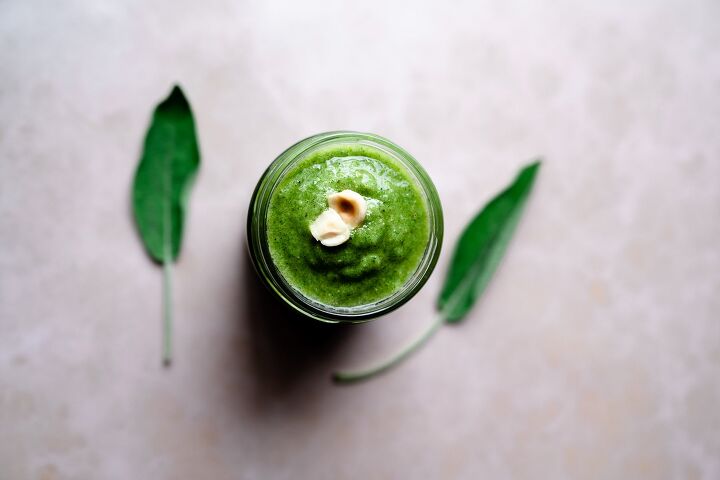





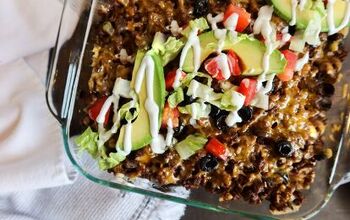



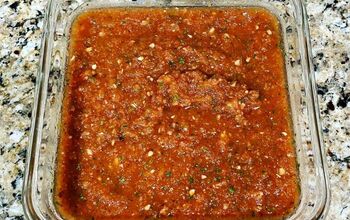





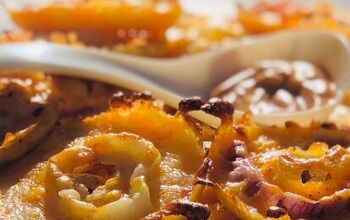





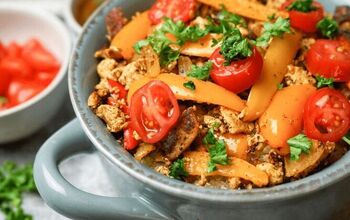
Comments
Share your thoughts, or ask a question!